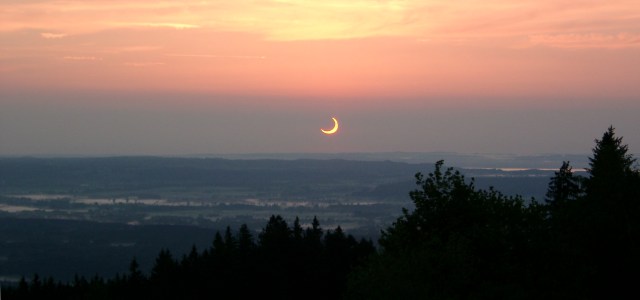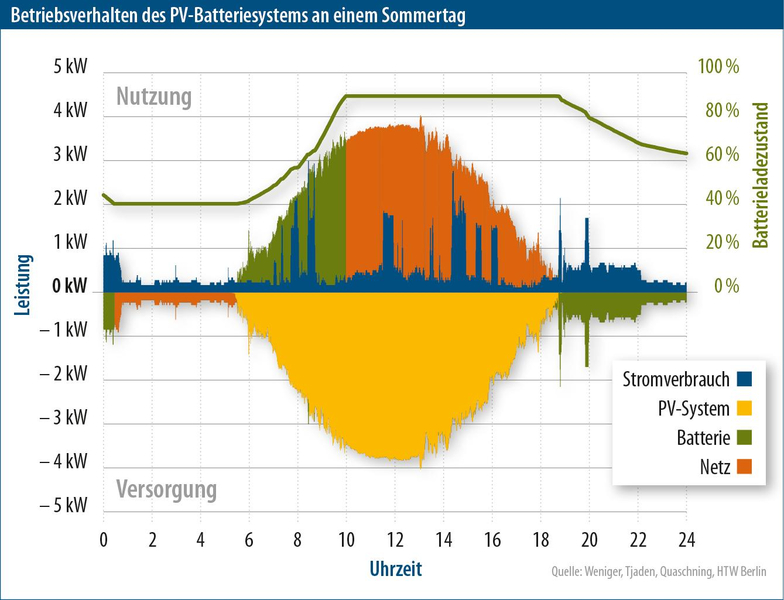On 20 March 2015, a partial solar eclipse will pass over Germany. Craig Morris says the impact will provide a glimpse of a future in which most households not only have solar roofs, but also battery storage.

What does a solar eclipse have in common with battery storage? More than one might think, at least for PV. (Photo by Schtone, CC BY-SA 3.0)
In my last post, I discussed the following chart:

Christian Hoehle at SMA, the world’s largest inverter manufacturer (inverters connect solar panels to the grid), wrote me to point out that the chart showed something I overlooked in my last post: at around 10 AM, the green area above the baseline (solar power stored in batteries) suddenly turns into the orange area (solar power exported to the grid) when the battery reaches its maximum state of charge (green line at the top). If this happens on a grand scale, the effect would pose a challenge for the grid – on practically every sunny day.
We will soon see what such an event might look like. In March, Germany will have a partial eclipse, the first major one since it installed so much solar. Indeed, the event will be the first eclipse in the history of mankind that could have a major impact on a power supply system. The only thing that might keep the impact in check is the weather; if it is a very cloudy day, the ramp in solar power will be drastically smaller (for the sake of experimentation, I certainly will hope for cloudless skies).
I most recently wrote about the upcoming eclipse here. That article includes a video (see below). It shows the kind of ramp we might have. The power storage of German household PV arrays is shown in the chart above. It looks a lot like the curve in the video below on the right, except that the first bump does not exist; up to around 10 AM, all of the solar power generated would go directly into batteries. The ramp would then start from closer to zero. And to be fair, the incline below looks more like a cliff than a ramp.
On the left, we see the amount of sunlight over Germany across the day under a cloudless sky on 20 March 2015, when the next solar eclipse takes place. On the right, we see power production from PV from that amount of sunlight, with the impact of the solar eclipse shown above that curve.
Note that the researcher who created the visualization, renewable energy Professor Volker Quaschning, says the event in March is unlikely to be a problem; if solar ramps from, say, 15 percent to 65 percent of its output capacity, we are talking about 50 percent of the maximum amount that could be generated that day, which I estimated at just over 10 GW here. A ramp of that size in one hour is a lot (probably a seventh of total demand), but certainly not something that is likely to cause severe problems.
But what if we have a ramp like that every day because of solar storage? First, let’s take a look at how many households we are talking about. Fraunhofer ISE’s latest photovoltaics report from October contains the following chart:
 Almost all of Germany’s PV was installed between 2009 and today, and the segment with the smallest arrays (up to 10 kW) makes up the smallest share of total installed capacity. Roughly, the green area at the bottom during those years covers no more than a sixth of the total market. Germany now has around 36 GW installed, so households make up roughly 6 GW. These are the systems likely to have the power curve in the first chart above. It’s not a lot, and it gets much smaller when we consider that battery storage is still quite rare at a mere 15,000 out of 800,000 systems smaller than 25 kilowatts.
Almost all of Germany’s PV was installed between 2009 and today, and the segment with the smallest arrays (up to 10 kW) makes up the smallest share of total installed capacity. Roughly, the green area at the bottom during those years covers no more than a sixth of the total market. Germany now has around 36 GW installed, so households make up roughly 6 GW. These are the systems likely to have the power curve in the first chart above. It’s not a lot, and it gets much smaller when we consider that battery storage is still quite rare at a mere 15,000 out of 800,000 systems smaller than 25 kilowatts.
We could therefore sit back and relax. After all, we are a long way from having serious problems from a sudden ramp resulting from solar power with storage in households. But there is little to stop the trend towards solar + storage in households at the moment, and the ramp would make itself felt increasingly. Most scenarios for 2050 have quite a bit of PV installed, and they range wildly – 200 GW by IWES, but only 67 GW in the German government’s (somewhat outdated) scenario from 2011 for 2050. If we end up with much more household solar + storage, we could have such ramps every sunny day.
Granted, all of these systems would not start exporting power to the grid at once, but they generally would across a short timeframe, such as an hour, at least as long as we focus on storing power relative to personal consumption.
The solution is obvious: all storage should focus on what the grid needs, not on covering personal consumption. Tailoring household battery systems to what the grid needs is not even possible at the moment. The market does not send out such signals. The German government should change the focus of storage. Otherwise, in a few decades, Germany will be simulating a solar eclipse every sunny morning.
Craig Morris (@PPchef) is the lead author of German Energy Transition. He directs Petite Planète and writes every workday for Renewables International.
Your failure to recognize how load control can be used to optimize personal consumption and/or maximize consumption of low wholesale prices is astounding. The more PV and Wind you add into a system the more it will drive the price of electricity down when these resources peak. What needs to be done is to connect consumers with price signals, use smart loads to capture the low prices and then use smart meters to automate the accounting.
Maximizing personal self-consumption uses the exact same technologies that non-solar owners would use to maximize the consumption or cheap electricity and minimize the consumption of expensive electricity. How hard is this to understand? In a rationally designed system what’s good for the consumer is aligned with what’s good for the grid. All you need to do is imagine solar/wind being the cheapest resources on the system. Maybe they aren’t at the moment but they’re clearly headed there.
How do you handle ramps? You could use fast ramping combustion turbines during the big ramps. The high prices associated with the ramping periods would be transmitted to consumers and smart loads would act to avoid the higher prices. You’d expect a spectrum of consumers that’s much like the current spectrum of generation. Some types of consumption will be very flexible and price responsive (water heating) while others won’t be all that flexible (TV, lighing).
Impact of Solar Eclipse means a kind of suspension of or obstruction to natural energy to the Earth for a period the eclipse begins to the end, which process does not usually last more than couple of hours at the most. But it can be imagined that the couple of hours phenomenon takes lot of time say some days before to come to the effective stage astronomers identify as solar eclipse or lunar eclipse. This could remain for a time which could be anything say a few days after the eclipse has reached effective stage. It is believed that the natural energy flowing from the Sun keeps things alive on Earth. So the impact of solar eclipse on 20 March 2015 would obviously plunge countries or regions into darkness wherever it is visible. This time it is Europe and some other regions where the eclipse would be visible. So whatever is dependent upon solar energy directly could be affected. Man made energy seems to be a different thing and perhaps may not be affected.
But there are messages from unseen powers people call spiritual. The total solar eclipse happens to be in the last sign sign of the zodiac.Planetary influences flowing to the Earth , as per astrology, seem to be to weaken the strong. These in combination with solar eclipse could be construed to mean a difficult time ahead.